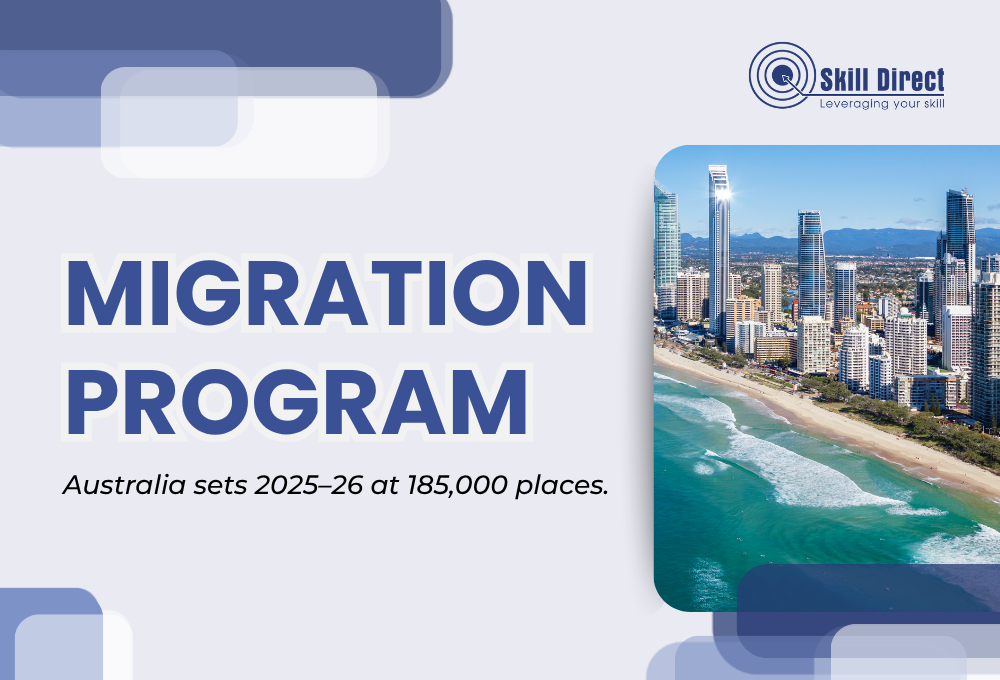In the 2025–2026 financial year, Australia has announced new targets and directions for its Migration Program. What’s different in this year’s migration agenda? Let’s update together with Skill Direct on the noteworthy changes!
1. What are the targets of the Migration Program?
From 2 September 2025, the Australian Government announced that the 2025–2026 Migration Program will be maintained at 185,000 places, the same level as in the 2024–2025 financial year.

This year, the program continues to focus on the skills stream, aiming to increase workforce participation and expand the human resources size, mainly because Australia is facing an aging population.
In the “Intergenerational Report 2023 at a glance”, it is projected that over the next 40 years the population aged 65+ will more than double, those aged 85+ will more than triple, and those aged 100+ will increase six-fold, creating a larger demand for young, skilled workers.
2. Migration Program trends over recent years
Over the past two years, the targets for Australia’s Migration Program have remained largely stable, mostly unchanged from the prior year.
Here is a summary of the specific situation:
- Skill stream (about 132,200 places – roughly 71 %) is the line that focuses on skilled workers to boost productivity and address workforce shortages, especially in regions outside the three major cities (Sydney, Melbourne and Brisbane).
- Family stream (about 52,500 places – roughly 28 %) covers partner and family-sponsored migration, enabling family reunification.
- Special Eligibility stream (a much smaller number of places, only 300 places) is reserved for special cases, for instance, permanent residents returning to Australia after time abroad. (Though exact figures vary by year.)
Please take a look at the detailed allocation for each year below:
| Visa Stream | Visa Category | 2023–24 Planning levels | 2024–25 Planning levels | 2025–26 Planning levels |
| Skill | Employer Sponsored | 36,825 | 44,000 | 44,000 |
| Skilled Independent | 30,375 | 16,900 | 16,900 | |
| Regional | 32,300 | 33,000 | 33,000 | |
| State/Territory Nominated | 30,400 | 33,000 | 33,000 | |
| Business Innovation & Investment | 1,900 | 1,000 | 1,000 | |
| Talent and Innovation |
|
|
4,300 | |
| Global Talent (Independent) | 5,000 | 4,000 |
|
|
| Distinguished Talent | 300 | 300 |
|
|
| Skill Total | 137,100 | 132,200 | 132,200 | |
| Family | Partner | 40,500 | 40,500 | 40,500 |
| Parent | 8,500 | 8,500 | 8,500 | |
| Child | 3,000 | 3,000 | 3,000 | |
| Other Family | 500 | 500 | 500 | |
| Family Total | 52,500 | 52,500 | 52,500 | |
| Special Eligibility | 400 | 300 | 300 | |
| Total Migration Program | 190,000 | 185,000 | 185,000 |
3. Key migration trends in 2025-26
Entering the 2025-26 financial year, the Australian Department of Home Affairs has not yet announced the official quotas for each state. As a result, state governments are still unable to establish clear directions for their occupation groups. As of now, only Victoria, Western Australia, and South Australia have temporarily opened credits for certain applicants, but the numbers remain quite limited.
This indicates that the overall trend this year is a more cautious approach by the government in allocating quotas, taking more time to carefully assess actual labor market demands before expanding invitations. The goal has shifted from quantity to quality, focusing on attracting skilled candidates who can accurately address specific labor shortages across different regions.
4. Migration experts’ insights
From the above migration trends, it is an evidence that the Australian Government is broadening opportunities for highly skilled workers who can directly contribute to economic growth and address workforce shortages across various sectors.
Moreover, the expansion of quotas for Employer Sponsored visas, along with active recruitment efforts from states and territories for essential occupations, has opened new opportunities for Vietnamese workers particularly for those with strong professional backgrounds, practical work experience, and good English proficiency.
So, which occupations offer the best prospects for Vietnamese applicants, and how should you prepare to align with this year’s Migration Program? Let’s explore detailed insights from Skill Direct migration experts below!
4.1 Predicting career opportunities for Vietnamese applicants
According to the Occupation Shortage List released by the Australian Government, many occupations are currently facing severe labor shortages. This means that if you already have relevant work experience, strong professional skills, and good English proficiency, your chances of living and working in Australia are higher than ever.
Below are some of the key industries that Vietnamese applicants may want to consider.

The first, engineering, technical, and construction sectors
This group is considered one of the top priorities for 2025–2026, as Australia continues to invest heavily in infrastructure, housing, and commercial projects nationwide. Positions such as welders, electricians, mechanical technicians, builders, painters, carpenters, tilers, plumbers, bricklayers, and roofers are all listed on the long-term skill shortage list.
With their diligence, craftsmanship, and eagerness to learn, Vietnamese workers can confidently build a stable career in Australia through this sector.
The second, health and aged care
Australia is entering a period of rapid population ageing, which has significantly increased the demand for healthcare professionals particularly nurses, aged care workers, and disability support workers.
This need is even more pressing in remote and regional areas, where the local workforce remains limited. Therefore, if you have qualifications or experience in healthcare, nursing, or community care, this is an excellent opportunity to build a long-term career in Australia.
The third, agriculture
As a country with deep agricultural roots, Vietnamese workers possess strong skills in cultivation, crop management, and livestock farming. Australia’s agricultural sector is currently facing a serious labor shortage, especially during harvest seasons.
For many, this represents a golden gateway to legally work in Australia, earn competitive income, and gain experience in a modern agricultural environment.
The fourth, early childhood education
Following the post-pandemic recovery, Australia’s economy has rebounded quickly, driving a surge in labor demand. As more parents return to work, the need for childcare services has risen sharply.
However, the workforce in this field remains insufficient making Early childhood teachers one of the occupations with the highest migration prospects today.
The last, bakery and culinary arts
Australia’s cultural diversity, shaped by a large immigrant population, keeps the food and hospitality industries in constant need of skilled workers. Pastry chefs, cooks, and restaurant staff with strong technical abilities and hands-on experience are always in high demand.
If you have professional certification, practical experience, and a passion for culinary arts, this could be a promising career pathway to work and settle in Australia.
There are still many other fields currently listed under Australia’s Occupation Shortage List. You can visit the official government website to check which occupations are in demand and understand the priority levels by state and territory.
By doing so, you can more easily identify which occupation best matches your background, while also planning to improve your skills, qualifications, and English proficiency to meet the requirements of this year’s Migration Program.
4.2 Expert advice from migration specialists
According to Skill Direct migration experts, understanding the Migration Program structure each year is a key factor in planning your pathway to Australia.
Based on the 2025–2026 trends, the Australian Government continues to prioritize skilled workers and employer-sponsored visa holders.
Here are several key recommendations from Skill Direct to help you prepare effectively:
- Clarify your career direction and assess labor shortages in your target field. This will help you choose an occupation that aligns with your skills and improve your chances of long-term settlement.
- Improve your English proficiency, as it plays a crucial role in gaining higher visa points and integrating smoothly into an international work environment.
- Gain practical experience and complete relevant trade or professional certifications, especially in high-demand sectors such as healthcare, agriculture, early childhood education, engineering, and culinary arts.
- Stay updated on the latest migration policies and announcements to choose the most suitable strategy for your personal situation.

In conclusion, it’s essential to understand the annual quotas of Australia’s Migration Program and, more importantly, to identify which occupations are truly in demand and have a higher chance of receiving an invitation. Choosing the right direction from the start will help you save time, reduce costs, and increase your chances of long-term settlement.
If you’re still unsure which occupations are currently prioritized by the Australian Government, let Skill Direct be your trusted partner, keeping you updated with the latest migration trends and guiding you toward the most suitable pathway.
Stay informed and confident about your Australian migration journey with Skill Direct.
